It was hot and humid with heat indexes over 100 degrees, when Sharon picked us up early in the morning in her nifty SUV for day two of our personal tour of Jackson County, MO. She was the sole tour guide today, driving one-handed and all. Our first stop was The Jackson County Historical Society archives on Independence Square. The JCHS is actually takes up ¼ of the courthouse building in the center of the square. The courthouse is not used as a courthouse these days, in fact, the JCHS had to do without running water at the time we visited. Proof of their dedication to preserving the past, I suppose. The courthouse building stands by itself in the middle of the square with a statue of President Truman in front of it.
Inside the archives were filled with shelves full of boxes and files and more files. David Jackson was at the center of it all, the only paid employee whose dedication and passion keeps things running smoothly as the collection grows. I felt proud and secure knowing the items I had contributed were being stored safely.


Then we piled back into the SUV and Sharon drove us to Fort Osage. The Fort Osage National Historical Landmark in Sibley, MO, is made up of an actual fort to duplicate the fort built in 1808 using some of the original features found during excavation, and an education center building. The original Fort Osage was erected under the direction of William Clark, of  The Lewis and Clark expedition, and Capt. Clemson of the U.S. Army to serve several purposes. Foremost it functioned as an outpost in the newly acquired Louisiana Purchase, housing soldiers to guard the new territory and protect the U.S. Factory Trade House there. It also helped the American government befriend the area’s Osage Indians. Finally, the fort offered Missouri’s early settlers and explorers a sanctuary from which to venture westward.
The Lewis and Clark expedition, and Capt. Clemson of the U.S. Army to serve several purposes. Foremost it functioned as an outpost in the newly acquired Louisiana Purchase, housing soldiers to guard the new territory and protect the U.S. Factory Trade House there. It also helped the American government befriend the area’s Osage Indians. Finally, the fort offered Missouri’s early settlers and explorers a sanctuary from which to venture westward.
Walking around the buildings in the heat, it was easy to imagine the living conditions there. Sharon planned on showing us the re-enactors that normally performed, but because of budget cut-backs, there was just one re-enactor around today. His story-telling skills, however, surely made up for the lack of personnel. Inside the store, he told us the history of the fort, and on a personal note, we found out he lived in a house in Independence that was owned by one of the McCoys. The exhibit in the education building was quite interesting too. We were surprised to learn that at a time when people were generally shorter in height than they are today, the Osage Indians were well over 6 feet tall.
Now it was time for lunch, so we headed to downtown Kansas City, MO, for some of the best barbeque around. We ate at a crazy, loud restaurant, as famous for their barbeque and it was for their customers. We inhaled some delicious, albeit 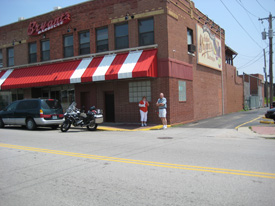 messy, sandwiches at Arthur Bryant’s Barbeque while soaking up the atmosphere as we watched everything from gun-toting agents of some kind to photos of Danny Glover on the wall.
messy, sandwiches at Arthur Bryant’s Barbeque while soaking up the atmosphere as we watched everything from gun-toting agents of some kind to photos of Danny Glover on the wall.
With our bellies full, we drove to Grand Ave. in Kansas City to the Arabia Steamboat Museum. Kansas City looked great to me, very clean, orderly, and well-kept. I especially liked the row of jazz clubs we passed with big colorful signs in front of them. Apparently, Kansas City has quite a jazz scene. Sharon suggested we watch the movie “Kansas City,” which we did after we got home. It takes place in many of these jazz clubs in the early 1900’s, and even has a scene filmed at a gas station in Independence that Brian Snyder later showed us.
We arrived at the Arabia Steamboat Museum, and, like uncovering the sunken Arabia Steamboat itself, finding the museum was like discovering a hidden treasure. The story is a real Missouri River adventure, if there ever was one. The Arabia Steamboat was a side-wheeler steamboat which hit a tree snag in the Missouri River and sank near what is today Parkville, MO, on Sept. 5, 1856. The upper decks stayed above water so that everyone could escape, making the only casualty a mule that was tied to sawmill equipment and forgotten. Within a few days, the entire boat sank in the mud of the river, and over time the river shifted to the east, which erased any traces of what had happened.
In 1987, David Hawley, a local business owner, set out to find the boat. He and his team, father Bob, brother Greg, and friends Jerry Mackey and David Luttrell, not only found the ship 45 feet under-ground, they personally raised the funds to excavate much of its contents for preservation. It turned into a life-long project for these ambitious men, which still goes on today as they continue to restore items from the wreck for display. The merchandise that has been recovered brings the year 1856 to life as you see the contents of crates of elegant china, hundreds of jars of preserved food that is still edible, hats, shoes, tools and weapons, you name it. Even the skeleton of the poor mule is laid out for display. It is an awe-inspiring collection to say the least, and it made me wonder why the exhibit wasn’t more well-known. Perhaps it was just another example of the humble spirit of the fine people of Missouri. The following photos show Greg with part of the steam engine, and Sharon and I beside the paddle wheel.
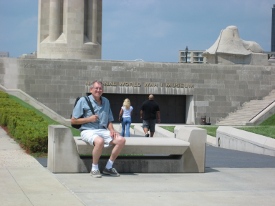 Greg was smiling from ear to ear when Sharon suggested we go to the World War I Museum next, so off we went. The Museum was designated by Congress as the United States’ official World War I Museum in 2004, opening to the public on December 2, 2006, as the National World War I Museum at Liberty Memorial. Once again, I was impressed by the fact that its presence was in large part due to the sheer tenacity of the people of Kansas City. Just two weeks after the Armistice, concerned citizens prompted Kansas City leaders to meet to discuss the need for the creation of a lasting monument to the men and women who had served and/or died in the War. R. A. Long, the founding president of the Liberty Memorial Association, said, “From its inception it was intended that this Memorial should represent on the part of all people, a living expression for all time of the gratitude of a grateful people to those who offered and who gave their lives in defense of liberty and our country.” A community-based fundraising drive in 1919, organized and led by the Liberty Memorial Association, raised over $2.5 million in just ten days. This staggering accomplishment for the time reflected the passion of public sentiment for the Great War that had dramatically changed the world.
Greg was smiling from ear to ear when Sharon suggested we go to the World War I Museum next, so off we went. The Museum was designated by Congress as the United States’ official World War I Museum in 2004, opening to the public on December 2, 2006, as the National World War I Museum at Liberty Memorial. Once again, I was impressed by the fact that its presence was in large part due to the sheer tenacity of the people of Kansas City. Just two weeks after the Armistice, concerned citizens prompted Kansas City leaders to meet to discuss the need for the creation of a lasting monument to the men and women who had served and/or died in the War. R. A. Long, the founding president of the Liberty Memorial Association, said, “From its inception it was intended that this Memorial should represent on the part of all people, a living expression for all time of the gratitude of a grateful people to those who offered and who gave their lives in defense of liberty and our country.” A community-based fundraising drive in 1919, organized and led by the Liberty Memorial Association, raised over $2.5 million in just ten days. This staggering accomplishment for the time reflected the passion of public sentiment for the Great War that had dramatically changed the world.
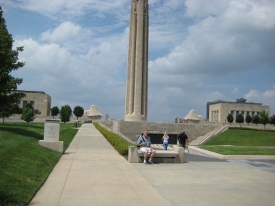 Over time the physical structure of the Liberty Memorial deteriorated, and in 1994 it was closed due to safety concerns. In 1998 the public voiced its support for the Liberty Memorial once again by passing a half-cent sales tax for 18 months to support the restoration. While revitalizing the Liberty Memorial, plans took shape for expanding the site by building a museum. The Liberty Memorial Association had been collecting objects and documents related to World War I since 1920, and the new museum was envisioned as an inspiring and engaging experience for visitors to see the collection. In total, the Liberty Memorial Association raised $102 million dollars for the restoration and expansion. Supporters included the City of Kansas City, the State of Missouri, the United Sates Federal Government, and generous individual donors. I was especially impressed with the modern design of the museum, which had the entrance going under ground. Once inside, there was a huge glass floor where you walked about 10 feet above 9,000 poppies on the floor below. Each poppy represented 1000 combatant deaths during WWI.
Over time the physical structure of the Liberty Memorial deteriorated, and in 1994 it was closed due to safety concerns. In 1998 the public voiced its support for the Liberty Memorial once again by passing a half-cent sales tax for 18 months to support the restoration. While revitalizing the Liberty Memorial, plans took shape for expanding the site by building a museum. The Liberty Memorial Association had been collecting objects and documents related to World War I since 1920, and the new museum was envisioned as an inspiring and engaging experience for visitors to see the collection. In total, the Liberty Memorial Association raised $102 million dollars for the restoration and expansion. Supporters included the City of Kansas City, the State of Missouri, the United Sates Federal Government, and generous individual donors. I was especially impressed with the modern design of the museum, which had the entrance going under ground. Once inside, there was a huge glass floor where you walked about 10 feet above 9,000 poppies on the floor below. Each poppy represented 1000 combatant deaths during WWI.
It was evening now, and time to make our final stop before heading back to Independence. And as the saying goes, our final stop was last, but not least by any means because we were headed for the memorial and final resting place of philanthropist and murder victim, Col. Thomas Swope in Swope Park. Thomas Swope came to Kansas City in 1855 from Kentucky with some inheritance money and bought up quite a bit of land. He made his fortune later selling and developing the land as Kansas City became settled. He prided himself on giving to charities, donating large sums to establish a hospital, contributing to the humane society, the YMCA, and in 1896 he gave the city the park that today bears his name. The park was much larger than I expected, covering 1332 acres, including 2 golf courses and a zoo. It was actually so large that Sharon had a hard time finding the memorial inside the park. To give you an idea of the size of the park, you can see the tiny memorial in the photo below, between the flagpole and the square white plaque as we saw it from one end of the park. Then you see a view from beside the memorial as it looks over the park. It was a peaceful yet imposing structure, much like its benefactor, who preferred to watch the celebration and extravaganza the city had in his honor for contributing the park from afar. (As described in “The Strange Story of Col. Swope & Dr. Hyde,” by Ralph Monaco.)
At the end of the day, I couldn’t help but be amazed at the accomplishments and humility of the people of this area, far from the fanfare of the east coast and large cities. Everyone from Sharon, tirelessly showing us around and explaining the city’s history, to David, selflessly working to preserve the past at the historical society, to the lone storyteller in the heat at Ft. Osage, committed to bringing the harsh life of early settlers to life, to the hard-workers dishing out top-notch barbeque in Kansas City, to the salvage team of the Arabia Steamboat, raising the artifacts and the funds to do so by themselves, to the tremendous effort and compassion it took to assemble the WWI memorial, museum and collection inside it, to the courage, vision, and enormous heart of Col. Thomas Swope. All stories of dedication, passion and accomplishment without seeking praise or reward. I could only hope some of these characteristics would rub off on me.
How interesting, I thought, that our next day would center around the actions taken by Dr. Hyde in 1909, whose character was in sharp contrast to those I had experienced today. After having dinner at a German restaurant with Brian and Sharon in Independence, we returned to The Higher Ground for the night.
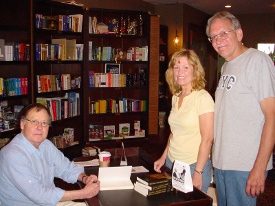 It was raining hard when we ventured out on the morning of June 12, 2010, having just enough time to shop for souvenirs at Independence Square before attending the book signing of Giles Fowler, author of “Deaths on Pleasant Street.” We actually didn’t have much luck finding traditional souvenirs, which was probably a tribute to the fact that Independence and its history are not yet commercialized. We were, therefore, the first to arrive at the store, ‘Wild About Harry,” which was great because I had plenty of time to talk to Mr. Fowler alone. In fact, during our visit, the electricity even went out for a while, making it feel all the more like a personal visit. The store was classy and homey at the same time, having been designed to be a tribute to Harry Truman, it catered to “things men like,” like books, office things, civil war relics, etc. Mr. Fowler was quite charming, advising us in a serious tone of some errors he recently became aware in his book, and how he going to have a corrected 2nd edition out soon. I enthusiastically bought five books, which he graciously signed.
It was raining hard when we ventured out on the morning of June 12, 2010, having just enough time to shop for souvenirs at Independence Square before attending the book signing of Giles Fowler, author of “Deaths on Pleasant Street.” We actually didn’t have much luck finding traditional souvenirs, which was probably a tribute to the fact that Independence and its history are not yet commercialized. We were, therefore, the first to arrive at the store, ‘Wild About Harry,” which was great because I had plenty of time to talk to Mr. Fowler alone. In fact, during our visit, the electricity even went out for a while, making it feel all the more like a personal visit. The store was classy and homey at the same time, having been designed to be a tribute to Harry Truman, it catered to “things men like,” like books, office things, civil war relics, etc. Mr. Fowler was quite charming, advising us in a serious tone of some errors he recently became aware in his book, and how he going to have a corrected 2nd edition out soon. I enthusiastically bought five books, which he graciously signed.
 With time to kill before we needed to get ready to attend the trial re-enactment at 2:00, we headed out to see a few more sights. The first place we went to was the site where the Swope mansion had been, and, of course, the murders took place. As I stood there, I imagined everything that happened on those cold nights, from the nurses and doctors rushing in and out of the huge gothic mansion to Dr. Hyde smashing the cyanide capsule on the snow-covered sidewalk down the street.
With time to kill before we needed to get ready to attend the trial re-enactment at 2:00, we headed out to see a few more sights. The first place we went to was the site where the Swope mansion had been, and, of course, the murders took place. As I stood there, I imagined everything that happened on those cold nights, from the nurses and doctors rushing in and out of the huge gothic mansion to Dr. Hyde smashing the cyanide capsule on the snow-covered sidewalk down the street.

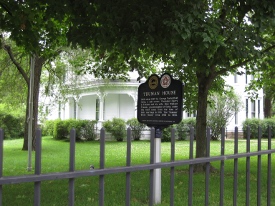 After that, we took a peek at the Truman house, and then on to lunch at Clinton’s Soda Fountain.
After that, we took a peek at the Truman house, and then on to lunch at Clinton’s Soda Fountain.
Clinton’s Soda Fountain was the only place we went that truly seemed designed for tourists. Its claim to fame is being where Harry Truman worked as a boy. He actually worked there at a soda fountain business, although it was not the current business. We had to wait through a long line of tourists, but finally had lunch at the counter and even purchased our long-desired tacky souvenir tee-shirts, etc. What I find most interesting about the place though is a story the Snyders told us about a poor woman who worked there during the time when hospitals were segregated. The poor thing ended up having to deliver her baby in a back room since she couldn’t make it to the correct hospital in time. They even said she ended up naming her baby “Clinton” in honor of his birthplace.
We headed back to the hotel, at this point, to change clothes in preparation for the “Trial of the Century,” the re-enactment of the Swope-Hyde murder trial, taking place at the Truman Memorial Building. The building was within walking distance, so we scurried there and met Sharon and Brian for the big show. The place was packed with over 400 people, anxious to experience this famous trial. We weren’t the only ones who traveled a far distance to attend the show either. One pair of ladies came all the way from Texas. The auditorium was more of a school stage set-up, with the stage being along side a gymnasium floor, with permanent chairs on the upper level only. Wanting to get a good view of the show, we sat close in metal folding chairs in front of the cold air-conditioning fan. As uncomfortable as it was, I still felt privileged to see this special performance.
 The characters in the play were all dressed in clothes of the period, and they were actual judges and lawyers in real life. Lawyer and author Ralph Monaco, II, played Col. Thomas Swope, who narrated the story from beyond the grave. This was a wonderful way to fill the audience in on the story that lead up to the trial. The witnesses and lawyers stated their cases and really drew you into the story. We found out later that they didn’t even have lines to memorize. The actors knew the story so well, they just made it up as they went. This technique helped I’m sure, when they had microphone trouble and had to improvise even more. The trial they portrayed was the first trial in 1910. There were actually several more trials that are still studied in many law schools today, as Maggie Swope tried again and again to convict Dr. Hyde of the deaths of her brother-in-law, his cousin, and her son, and trying to murder about 5 other members of the family (including herself) with poison. After reading the facts of the case, it’s pretty obvious that he committed the crimes, but the primitive technology of the times and skills of the defense lawyers kept Dr. Hyde from being convicted.
The characters in the play were all dressed in clothes of the period, and they were actual judges and lawyers in real life. Lawyer and author Ralph Monaco, II, played Col. Thomas Swope, who narrated the story from beyond the grave. This was a wonderful way to fill the audience in on the story that lead up to the trial. The witnesses and lawyers stated their cases and really drew you into the story. We found out later that they didn’t even have lines to memorize. The actors knew the story so well, they just made it up as they went. This technique helped I’m sure, when they had microphone trouble and had to improvise even more. The trial they portrayed was the first trial in 1910. There were actually several more trials that are still studied in many law schools today, as Maggie Swope tried again and again to convict Dr. Hyde of the deaths of her brother-in-law, his cousin, and her son, and trying to murder about 5 other members of the family (including herself) with poison. After reading the facts of the case, it’s pretty obvious that he committed the crimes, but the primitive technology of the times and skills of the defense lawyers kept Dr. Hyde from being convicted.
To read the entire story of the Swope murders, you can order Giles Fowler’s book, “Deaths on Pleasant Street,” and Ralph Monaco’s book, “The Strange Story of Col. Swope and Dr. Hyde,” from the Jackson County Historical Society’s website. You will find both of them listed among other books about Independence.
The fun of the trial re-enactment may have been over, but the party had just begun as we walked a few blocks to attend a private party at Ophelia’s Restaurant and Inn. The elegant Ophelia’s, like many other things I found there, was more than just a beautiful place of business on Independence Square, it was a labor of love by Ken and Cindy McClain who opened it in an effort to revive the square.
The party at Ophelia’s was the perfect way to celebrate the end of our wonderful trip. We had such fun talking to the cast members, who were still in custome, meeting more interesting members of the community, helping ourselves to wine and sandwiches, and spending more time with our new friends, the Snyders, Giles Fowler, David Jackson, and others. I was so thankful to the Jackson County Historical Society and the City of Independence Parks and Recreation for sponsoring these wonderful events.
The fun continued as we walked to Sharon and Brian’s house to chat for the remainder of the evening, and met up with some very interesting neighbors. The first thing that caught my eye was the sign that identified The Minor House. The Minor house was the home of William McCoy’s daughter Nancy McCoy Minor and husband Charles Minor. They raised daughters Eleanor and Grace in the home where the daughters continued to live for eighty years. It’s interesting to note that both parents were deaf, and since the daughters were not deaf, they actually spent a lot of time with grandparents William and Eleanor McCoy. Daughters Grace and Eleanor never married and were members of Mrs. Bess Wallace Truman’s Tuesday Bridge Club. They were also guests of President Truman in Washington during his presidency. After Eleanor passed away, Grace moved out and sold the house to a descendant of Samuel Weston, who originally built the house. The new owner restored the property and it is now divided into apartments.
As if like magic, as we passed The Minor House, the neighbors in the next two houses ran out to greet us with stories to tell. The owners of the big spooky looking house next door had stories of ghosts and unexplained occurrences, and the owners of the next house down had actually been victims of Katrina and had recently relocated to Independence. What a neighborhood!
We chatted with the Snyders during our final visit to the McCoy house before heading home the next morning. I can truly say that I will always hold this trip close to my heart. I made new friends, heard about old foes, and discovered family rich in history. I feel so fortunate now, and appreciate the wonderful legacy left to me in Independence, a special place that now feels like home.
Photo Gallery
The following photos show the generations as they connect me to my great great grandfather in Independence beginning with John and Jane McCoy in their Independence home on their 50th wedding anniversary. Next you see their son, Joseph Addison McCoy with his son, Joseph Chrisman McCoy. The following photo is of Joseph Chrisman McCoy as an adult with this son, Joseph Chrisman McCoy, Jr. Finally, you see Joseph Chrisman McCoy, Jr., as an adult in the 1970’s with daughters, Kathleen Ann McCoy (myself, in the middle) and Amy Elizabeth McCoy.
The final group of photos show Joseph Chrisman McCoy, Jr., and wife Kathleen Barbeau McCoy (my parents) on their visit to Independence in 1970’s. The first photo is in front of the Minor house with Grace Minor and Margaret Woodson. Then it is Joe McCoy and Grace Minor inside the Minor house. Final photo is Joe and ladies in front of the William McCoy house.
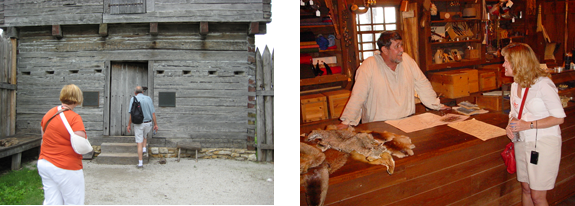

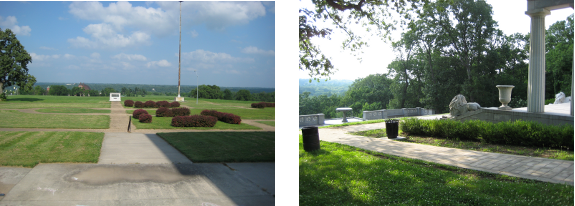
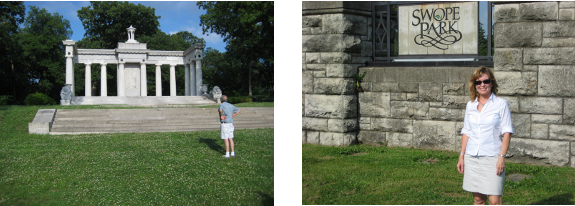
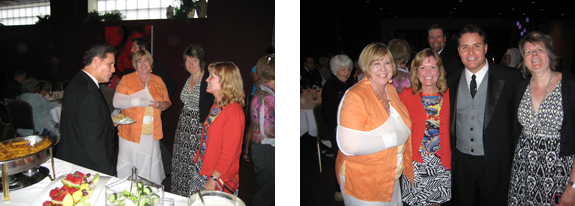


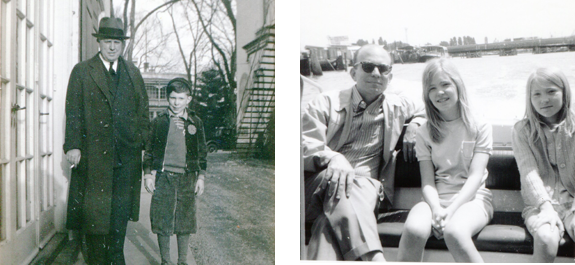
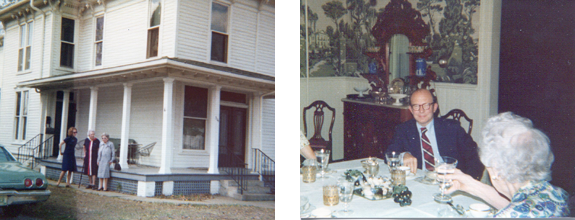
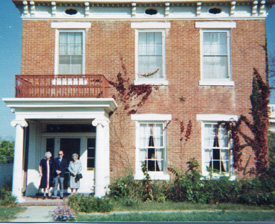

In 1957, my family moved to Kansas City and my mother got a job at the Kansas City, Missouri Public Library. One of her co-workers was Eleanor Minor. Miss Minor invited the women she worked with to a tea at her house and told my mother to bring me along( I was about five or six years old when this occurred).Mom thought Miss Minor was just being polite about inviting me and Mom drove from our house near the Plaza, to Independence( about a forty minute drive). Miss Minor asked, “where’s Betty?” and insisted Mom return to our house and pick me up. Mom called our home from the Minor’s home and told my older sisters to get me dressed up in my party dress and white party gloves. Mom drove back home, picked me up, and drove back to Independence. Although I have no memory of it , this is how I met Bess Wallace Truman- she was the guest that day at the tea. About a week ago, I started reading “Deaths on Pleasant Street” and when I saw the name Eleanor Minor, I wondered if that was the Eleanor Minor my late mother worked with at the library? I looked at the 1940 United States Census and saw that Eleanor was a librarian and Grace was a teacher and I knew then that these were the women my mother knew in the 1950’s.
Wow…what a fascinating story! So glad you’re reading “Deaths on Pleasant Street,” and yes it is the same Minors. I’ve read the book twice…something captivating about the people in that town. How nice of Miss Minor to insist you join the party. I’m so glad you shared that with me.